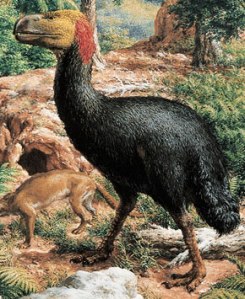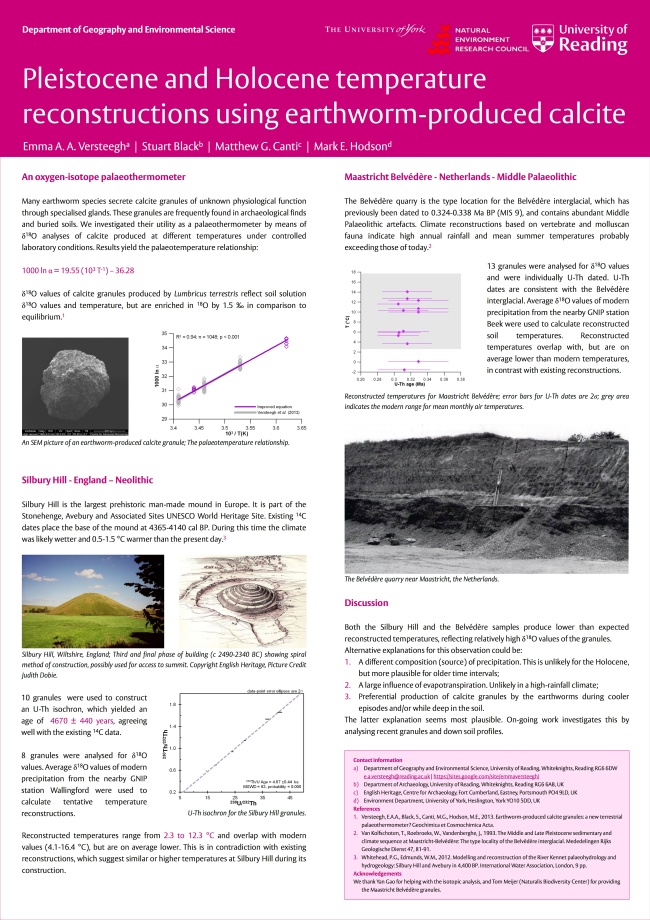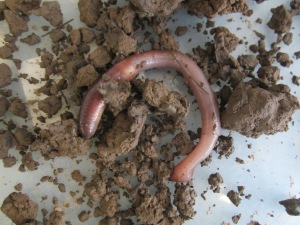My poster of last Wednesday
Category Archives: Oxygen isotopes
The early bird catches the worm

The “terror bird” Gastornis (http://research.amnh.org/)
For many of us being an early bird becomes progressively more difficult as conference fatigue takes its toll. I was glad to see a sizeable crowd managed to be there for the start of our session on the role of biominerals in biogeochemical cycling, which happened to be about birds and worms, and some other creatures.
Thomas Tütken showed us that the fearsome Eocene terror bird was neither a predator, nor a worm-catcher, but a gentle herbivorous giant instead! Also, the oxygen isotope composition of the bones of large herbivores forms a remarkably good archive of Cenozoic climate, agreeing well with the famous Zachos curve.
Then it was my turn to talk about worms, who are unexpected biomineralisers, and appear to precipitate atmospheric carbon dioxide in carbonate granules in the soil. Loredana Brinza studied metals in these granules, and demonstrated that they can significantly contribute to zinc immobilisation in polluted soils.
From animals we switched to plants, with two presentations about phytoliths: little chunks of silica produced by plants. Jean-Dominique Meunier and Eric Struyf showed that the contribution of phytoliths to global silicium cycling is much larger than previously thought and is of the same order of magnitude as the marine contribution of diatoms. Humans remove a lot of silicium from the global cycle by harvesting crops, and this likely reduces crop yields.
Going from the terrestrial to the marine realm, Ruth Carmichael spoke about nitrogen in bivalves and their potential for nitrogen sequestration as well as reconstruction of nitrogen cycling before human influences, using shells from middens that are thousands of years old. Adilah Ponnurangam stayed with the bivalves, but looked at rare-earth elements and showed that they reflect seawater composition.
The session ended with Michaël Hermoso presenting some meticulous laboratory culture experiments on coccolithophores, and size-related differences in carbon-isotope fractionation. All-in-all a very interesting morning, and a satisfying debut as a session chair.
Earthworms could help scientists ‘dig’ into past climates
A team of UK researchers believe earthworms could provide a window into past climates, allowing scientists to piece together the prevailing weather conditions thousands of years ago.
A laboratory study by researchers from the Universities of Reading and York has demonstrated that balls of calcium carbonate (small lumps of chalk-like material) excreted by the earthworm Lumbricus terrestris – commonly known as lobworms or nightcrawlers – maintain a memory of the temperature at which they were formed.
This, say the researchers, in an article in the journal Geochimica et Cosmochimica Acta, means that calcite granules, commonly recorded at sites of archaeological interest, have the potential to reveal important information about past climates which could be used to enhance and benchmark climate change models.
The study, which also involved English Heritage’s Centre for Archaeology, was funded by the Natural Environment Research Council (NERC).
Lead author Dr Emma Versteegh from the Department of Geography and Environmental Science at the University of Reading, said: “These chalk balls will allow us to reconstruct temperatures for specific time intervals in which they were formed. Reconstructions like this are interesting for archaeologists, because they give a climatic context to their finds. More importantly, climate proxies are the only means we have to study climate beyond the instrumental record, which only goes back about 150 years.
“This knowledge about past climates is of vital importance for developing and benchmarking climate models that make predictions for the future. Many different proxies already exist, but no proxy is perfect, or is available in every location, so it is good to have many different ones.”
The proof of concept study involved keeping modern-day Lumbricus terrestris at different temperatures, then carrying out isotopic testing on the calcite granules excreted. This successfully demonstrated that the granules remembered the temperature at which they were formed.
Principal Investigator Professor Mark Hodson from the University of York’s Environment Department, and formerly of the University of Reading, said: “There are many conflicting theories about why earthworms produce calcite granules, but until now, the small lumps of chalk-like material found in earthworm poo have been seen as little more than a biological curiosity. However, our research shows they may well have an important role to play, offering a window into past climates.”
The researchers are now gathering samples from archaeological sites dating back thousands of years in preparation for isotopic testing.
Dr Stuart Black, from the University of Reading’s Department of Archaeology, added: “We believe this new method of delving into past climates has distinct advantages over other biological proxies. For example, we believe it will work for the full seasonal range of temperatures, whereas methods such as tree rings, do not “record” during winter. In addition, because the chalk balls are found in direct context with archaeological finds, they will reveal temperatures at the same location. At present, links are often attempted with climate proxies many hundreds or even thousands of miles away.”
Mussel power
 Mussel power – ocean shells can help predict rise in sea levels
Mussel power – ocean shells can help predict rise in sea levels
Ocean mussels could be key to helping scientists predict more accurately the rise in sea levels caused by the melting of the Greenland Ice Sheet.
A University of Reading study has shown that mussel shells accurately record the amount of meltwater running off the ice sheet during the summer. The researchers believe analysing shells hundreds to thousands of years old will reveal how much Greenland meltwater, caused by the natural climate variability of the Earth, contributed to previous sea level fluctuations.
This information can then be fed into climate models allowing scientists to better predict the behaviour of the Ice Sheet during future variations in climate. Crucially this will also tell us how much melting is due to human influence.
Due to global warming the sheet melted at an unprecedented rate during 2012 with the thawed ice area jumping from 40% to 97% in just four days during July. Melting is predicted to raise global sea levels during the 21st century by up to 10 cm and if the sheet was to completely melt, which would take centuries, sea levels would rise by about seven metres. This could threaten low-lying countries like the Netherlands and less developed countries such as Bangladesh.
Dr Emma Versteegh, from the University of Reading’s Department of Geography and Environmental Sciences, who conducted the research with co-workers from Greenland and Denmark, said: “The Earth’s climate naturally varies over long timescales and there have been warm intervals before during which the amount the Greenland Ice Sheet melted might have varied considerably. Examples include the Holocene Climatic Optimum (roughly 9000 to 5000 years BC) and the Medieval Warm Period (~ AD 950 to 1250).
“Very little is known about the dynamics of Greenland Ice Sheet melting. In order to understand its behaviour and predict future melting, information on meltwater amounts during different climatic regimes is hugely important. However instrumental data only cover the last few decades, so other methods are needed to look further into the past.”
Using blue mussels found in different areas off the coast of West Greenland, Dr Versteegh found that the shells revealed the amount of meltwater running off the ice sheet during the summer. Mussels and other shells have been used before to reconstruct past climate, but this is the first time they have been used to indicate past meltwater amounts.
Dr Versteegh continued said: “Over several years we collected shells at different locations in Godthåbsfjord and also measured water composition and temperature. Meltwater is characterised by a very different oxygen isotopes composition than seawater. By analysing these isotopes in the mussels’ annual growth bands we will be able to reconstruct the melting of the Greenland Ice Sheet during several warm periods over the past 10,000 years. This will give climate scientists vital information on how the Earth’s natural variations in climate affect the Ice Sheet, and in turn sea levels, which they can use to further improve predictions of sea level rises stemming from climate change.”
Oxygen isotope ratios in the shell of Mytilus edulis: archives of glacier meltwater in Greenland is published on the Biogeosciences websites http://www.biogeosciences.net/
ENDS
For all media enquiries please contact James Barr, University of Reading Press Officer on 0118 378 7115 or by email on j.w.barr@reading.ac.uk
Follow us on Twitter | Like us on Facebook | Read our research blog ‘The Forum’
Notes for Editors
The University of Reading is ranked among the top 1% of universities in the world (THE World University Rankings 2012) and is one of the UK’s top research-intensive universities.
The University of Reading’s Department of Geography and Environmental Science has a strong research environment which focuses on key issues at home and abroad, from the social and economic impact of developments in the UK, to studies of Brazilian rainforests, Caribbean towns and livelihoods in Africa. The Department works with business and industry, charities and non-governmental organisations, and has links with other departments whose expertise provide a diverse and stimulating research environment.
Funders
- Greenland Climate Research Centre
- Danish Ministry of the Environment (Dancea);
- Aarhus University;
- Commission for Scientific Research in Greenland, Ministry of Education;
- Research and Nordic cooperation (IIN);
- Aage V Jensen Charity Foundation;
- Canada Excellence Research Chair Program (University of Manitoba, Canada)
Climate research with shells
This video is unfortunately in Dutch. It shows the work of two secondary school students whom I co-supervised during my PhD. They went on an expedition to Svalbard with their teacher and brought back some mussel shells, which they sampled, analysed for stable isotopes, and compared with shells from the Netherlands.
Freshwater mussels record droughts
To make a long story short, the freshwater mussels that grew in the monitoring experiment for over a year, indeed nicely recorded the environment. In this case that means their shell oxygen isotopic composition (δ18O values) reflected the δ18O values and temperature of the water they were living in:
water δ18O + temperature → shell δ18O

relationship between discharge (Q) and water oxygen isotope composition (δ18Ow) in the river Meuse (The Netherlands).
The next thing to find out was if this could be used to reconstruct floods or droughts in a river. In the river Meuse, there is a logarithmic relationship between discharge and water δ18O values.
By analysing shells from a wet time interval (1912-1918) and an extremely dry time interval (1969-1977) we found out that droughts with a very low river discharge are readily recorded by the shells. This is logical if you look at the graph. The water δ18O composition does not change very much between average and high discharges, but values become much higher when discharges (Q) are very low (at the left side of the graph).
This means that when we are going to analyse old shells, from archaeological finds or palaeogeographical samples in the Meuse River area, we will be able to recognise droughts.
If you’re interested in reading the full story, it can be found here (open access – free of charge).
Biogeosciences
A paper I wrote is now open for discussion, while it’s also in review. We discuss how mussels can record meltwater off the Greenland coast. Since this is an open access journal everybody can read it and comment on it, so feel free.
Oxygen isotopes
A lot of palaeoclimate research makes use of stable oxygen isotope compositions of various substances, like ice cores or microfossils. But what are isotopes and how do they end up in our climate records?

The Oxygen-18 isotope has an extra two neutrons, for a total of 10 neutrons and 8 protons, compared to the 8 neutrons and 8 protons in a normal oxygen atom. Picture from NASA.
Isotopes are different versions of atoms of the same element, but with a different mass. Oxygen, for example, has atomic number 8, which means its nucleus contains 8 protons. The amount of neutrons in the nucleus, however, can vary from 8 to 10, resulting in oxygen having three different isotopes known as 16O, 17O and 18O. Some isotopes are unstable and after some time split to form two new elements, a form of radioactive decay. The aforementioned oxygen isotopes are stable and occur naturally in various proportions (99.76, 0.035 and 0.20 %, respectively). Here I will only discuss 16O and 18O, since the amount of 17O in the natural environment is negligible. Because they’re all oxygen, they generally behave the same in chemical reactions, there are however some differences. A heavier isotope requires more energy to be mobilised in chemical reactions and processes like evaporation, with interesting consequences:
Water (H2O) of course contains a lot of oxygen atoms. When clouds form over the ocean, fewer of the heavy isotopes will evaporate, resulting in clouds that are depleted in 18O. When these clouds than move over land and start to produce rain, the molecules containing the heavy isotope will rain out first. This results in rain containing less and less 18O, the further you go land inwards.
This so called fractionation between light and heavy isotopes is most pronounced at low temperatures, since at high temperatures enough energy is available to mobilise both isotopes. So temperatures can also be reflected in oxygen isotope compositions. This is for example the case in in oxygen isotope records of microfossils from the ocean floor (benthis foraminifera). In the well-know ice cores both processes are at work, and result in an accurate reflection of ice ages and interglacials over the past several millions of years.






